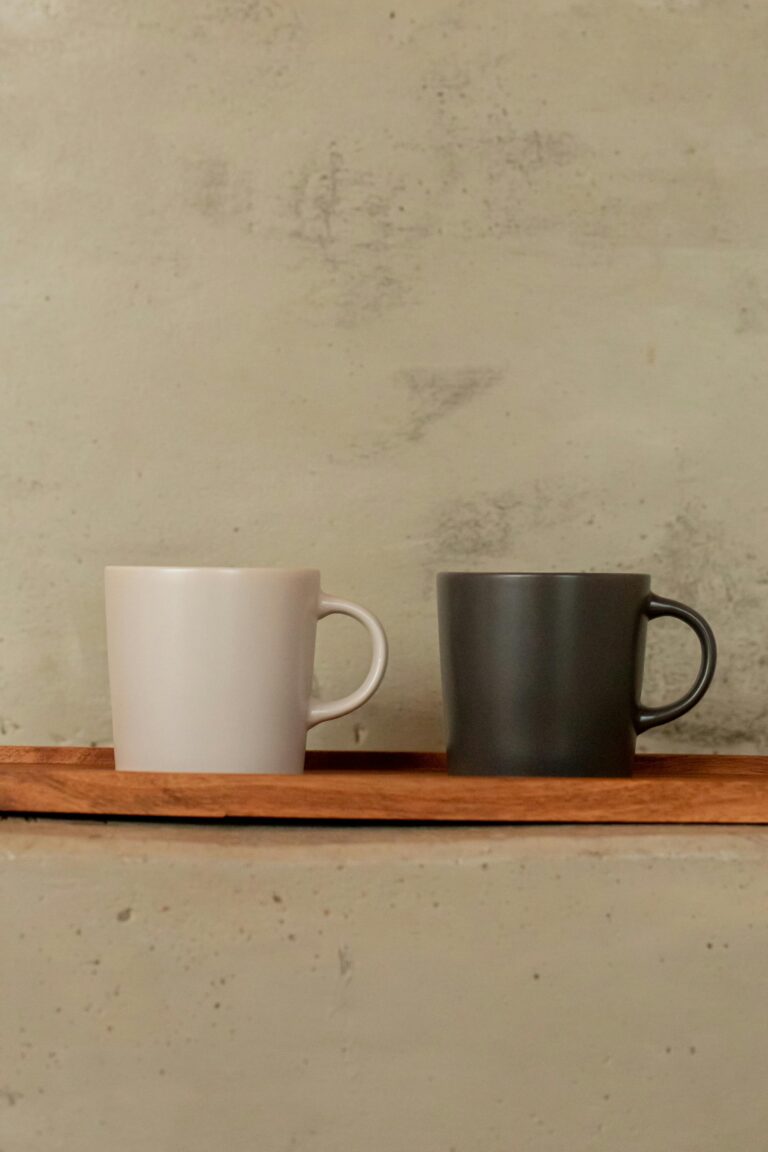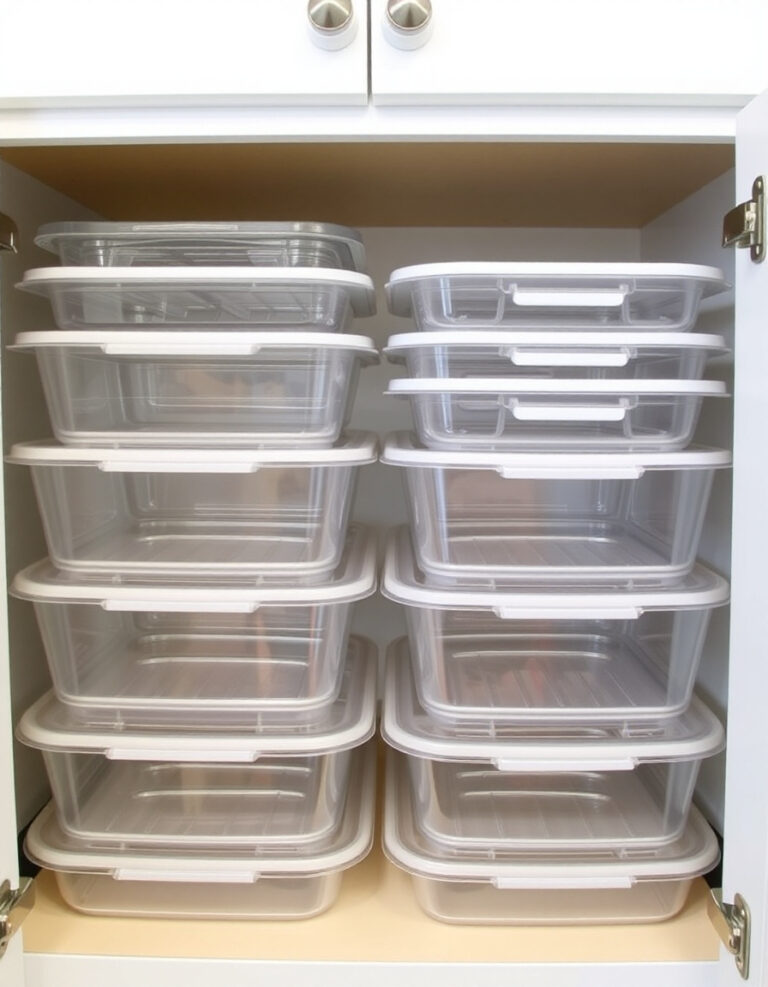When reusable containers refuse to nest, kitchen cabinets can turn chaotic fast. Mismatched lids, odd shapes, and containers from different sets take up valuable space. These six solutions can help you organize storage containers more efficiently, even when they won’t stack neatly inside each other.
Why Reusable Containers Stop Nesting Together

Most storage container sets work beautifully when they’re new and complete. But over time, things change.
You might add containers from different brands. Lids can warp in the dishwasher. Some pieces get lost or damaged. Before long, your reusable containers become a jumbled mess that refuses to cooperate.
The good news? You don’t need to replace everything to regain control of your kitchen storage.
1. Use Drawer Dividers to Separate Non-Nesting Containers by Size
Drawer dividers can create designated zones for containers that won’t stack. This method works especially well for shallow storage containers that tip over easily.
Measure your drawer space first. Then add adjustable dividers to create sections for small, medium, and large containers.
Keep lids in a separate section. This prevents you from digging through a pile every time you need one specific container.
2. Store Reusable Containers Vertically with Tension Rods
Tension rods offer a simple fix for awkward container storage. Install them vertically inside a deep cabinet or on a shelf.
Slide flat containers and lids between the rods. They’ll stand upright like files in a folder.
This approach works particularly well for rectangular food storage containers and baking dishes. You can see everything at once without unstacking.
3. Group Containers That Don’t Nest by Function Instead of Size
Sometimes the smartest solution for reusable containers is to forget about nesting altogether. Try organizing by purpose instead.
Create one zone for lunch-packing containers. Set up another area for leftover storage. Keep meal prep containers separate from small snack boxes.
This functional approach can make your kitchen storage more intuitive. You’ll grab what you need without hunting through mismatched pieces.
4. Add Stackable Bins to Contain Awkward Storage Container Shapes
Plastic bins with handles can corral containers that refuse to nest nicely. Choose clear storage bins so you can see what’s inside.
Place similar-sized containers in each bin. Stack the bins on pantry shelves or inside cabinets.
Label each bin by container type or size. This system keeps non-nesting pieces contained while maximizing vertical space.
5. Mount a Lid Organizer to Free Up Space for Container Storage
Lids often cause the biggest headache with container organization. When reusable containers don’t nest properly, stray lids make everything worse.
Install a vertical lid holder on the inside of a cabinet door. Or use a countertop organizer designed specifically for lids.
With lids stored separately, you can stack containers more loosely. They don’t need to nest perfectly when you have dedicated space for each piece.
6. Rotate Containers Based on Seasonal Kitchen Storage Needs
Not every container needs to stay in your main cabinet year-round. Consider rotating your storage container collection seasonally.
Keep everyday containers accessible. Move specialty pieces—like large picnic containers or holiday cookie tins—to higher shelves or basement storage.
This rotation approach can reduce clutter in your primary kitchen storage solutions area. You’ll work with a smaller, more manageable collection of reusable containers daily.
What to Keep in Mind with Container Storage Solutions
These solutions work best when you audit your collection first. Pull out containers you haven’t used in six months.
Check for missing lids or cracked pieces. Recycle or donate containers that no longer serve you well.
A smaller, more curated collection of reusable containers tends to stay organized longer. Even pieces that don’t nest can work together when you have the right amount.
FAQ
Why don’t my reusable containers nest together anymore?
Containers stop nesting for several reasons. Heat from dishwashers can warp plastic over time. Mixing different brands or container sets creates size mismatches.
Worn edges and small cracks might also prevent proper nesting. Even slight damage can throw off how containers fit together.
How to organize containers that won’t stack properly?
Try storing them vertically with tension rods or dividers. Group containers by function rather than size. Use bins to contain awkward shapes.
Separating lids from bases can also help. This gives you more flexibility in how you arrange non-stacking pieces.
What to do with mismatched food storage containers?
Keep only containers with matching lids. Donate or recycle pieces that lack pairs. Use mismatched containers for non-food storage like craft supplies or garage organization.
Consider dedicating one drawer to mismatched pieces you use occasionally. This keeps them accessible without cluttering your main kitchen storage area.
How to fix containers that don’t fit inside each other?
You can’t usually fix warped containers. Focus instead on organizing them differently. Vertical storage, drawer dividers, and bins offer practical alternatives to traditional nesting.
If containers are valuable to you, hand-washing instead of using the dishwasher might help preserve their shape over time.
Should I replace all my reusable containers with matching sets?
Replacing everything isn’t always necessary. Many households function well with mixed container collections. The key is having an organizational system that works for your space.
If you prefer uniformity, gradually replacing pieces as they wear out might feel more manageable than buying everything at once.
How many food storage containers does a kitchen actually need?
This depends on your cooking and meal prep habits. Start with 8-12 containers in various sizes. Add more if you meal prep extensively or pack multiple lunches daily.
Having too many containers can create as much chaos as having too few. Find the balance that matches your lifestyle and available storage space.
What’s the best way to store container lids separately?
Vertical lid organizers work well on cabinet doors. File-style organizers let you flip through lids easily. Some people prefer drawer dividers with designated lid sections.
Choose a method that fits your kitchen layout. The goal is accessing lids quickly without creating a jumbled pile.
Can I mix different brands of storage containers in one system?
You absolutely can mix brands. Focus on creating zones by size or function rather than trying to force different brands to nest. Many organizational methods work regardless of brand consistency.
The solutions in this post specifically address mixed collections. Pick the strategies that fit your cabinet space and daily routine.
Conclusion
Reusable containers don’t need to nest perfectly to stay organized. With the right approach, you can create a functional system for any collection.
Try one or two solutions from this list. You might find that vertical storage or functional grouping works better than traditional nesting anyway.
Your kitchen storage can feel manageable again, even with containers that refuse to cooperate.



